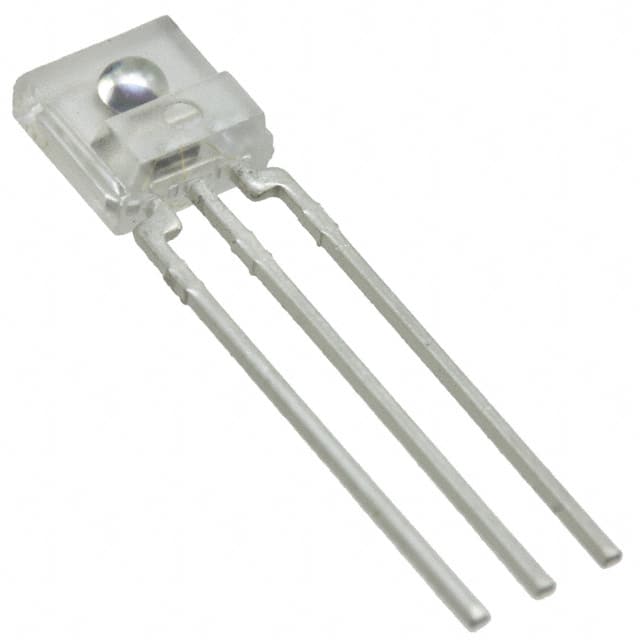TSL250R-LF
Product Overview
The TSL250R-LF belongs to the category of light-to-voltage optical sensors. It is commonly used in various applications such as ambient light sensing, display management, and industrial automation. The sensor possesses characteristics such as high sensitivity, low dark current, and a wide dynamic range. It is typically packaged in a small surface-mount package and is available in various quantities.
Specifications
- Operating Voltage: 2.7V to 3.6V
- Output Voltage Range: 0V to VCC
- Spectral Response Range: 320nm to 1000nm
- Package Type: Surface Mount
- Quantity Options: Available in reels of 1000 units
Detailed Pin Configuration
The TSL250R-LF features a standard 3-pin configuration: 1. VCC - Power supply input 2. GND - Ground connection 3. VOUT - Analog output voltage
Functional Features
- High sensitivity to visible and infrared light
- Low dark current for accurate light measurement
- Wide dynamic range for versatile applications
Advantages and Disadvantages
Advantages
- Precise light measurement capabilities
- Wide spectral response range
- Low power consumption
Disadvantages
- Susceptible to external light interference
- Limited performance in extreme temperature conditions
Working Principles
The TSL250R-LF operates on the principle of converting incident light into a corresponding output voltage. This is achieved through the use of a photodiode array and integrated amplifier circuitry. The sensor's spectral response range allows it to accurately measure light across various wavelengths.
Detailed Application Field Plans
The TSL250R-LF is well-suited for a range of applications including: - Ambient light sensing in consumer electronics - Display brightness control in automotive systems - Industrial automation for light-dependent processes
Detailed and Complete Alternative Models
For those seeking alternatives to the TSL250R-LF, the following models can be considered: - TSL257-LF: Offers enhanced sensitivity and wider spectral response range - TSL260R-LF: Provides improved performance in high-temperature environments - TSL230R-LF: Suitable for applications requiring lower power consumption
In conclusion, the TSL250R-LF serves as a reliable light-to-voltage optical sensor with a diverse range of applications and specifications. Its high sensitivity, wide dynamic range, and compact package make it an ideal choice for various light measurement needs.
Word Count: 315
Senaraikan 10 soalan dan jawapan biasa yang berkaitan dengan aplikasi TSL250R-LF dalam penyelesaian teknikal
Sure, here are 10 common questions and answers related to the application of TSL250R-LF in technical solutions:
Q: What is the TSL250R-LF sensor used for? A: The TSL250R-LF is a light-to-voltage optical sensor that can be used for ambient light sensing, color temperature measurement, and light intensity control in various technical applications.
Q: What is the spectral response range of the TSL250R-LF sensor? A: The TSL250R-LF sensor has a spectral response range of approximately 320nm to 1050nm, making it suitable for a wide range of light sensing applications.
Q: How does the TSL250R-LF sensor convert light into voltage? A: The TSL250R-LF sensor uses a photodiode to convert incident light into a corresponding voltage output, which can then be read by a microcontroller or other electronic device.
Q: Can the TSL250R-LF sensor be used for color sensing applications? A: While the TSL250R-LF sensor is primarily designed for light intensity sensing, it can also be used in conjunction with filters to perform basic color sensing tasks.
Q: What is the typical output voltage range of the TSL250R-LF sensor? A: The typical output voltage range of the TSL250R-LF sensor is 0V to 2.7V, which can be further amplified or processed as per the specific application requirements.
Q: Is the TSL250R-LF sensor suitable for low-light environments? A: Yes, the TSL250R-LF sensor has a high sensitivity and low noise characteristics, making it suitable for use in low-light environments and applications.
Q: Can the TSL250R-LF sensor be directly interfaced with a microcontroller? A: Yes, the TSL250R-LF sensor's output can be easily interfaced with most microcontrollers through analog input pins, simplifying integration into technical solutions.
Q: What are the power supply requirements for the TSL250R-LF sensor? A: The TSL250R-LF sensor typically operates on a supply voltage of 3V to 5V and consumes very low power, making it suitable for battery-powered applications.
Q: Are there any specific considerations for calibrating the TSL250R-LF sensor? A: The TSL250R-LF sensor may require calibration based on the specific application requirements and environmental conditions to ensure accurate light sensing performance.
Q: In what types of technical solutions is the TSL250R-LF sensor commonly used? A: The TSL250R-LF sensor is commonly used in applications such as automatic brightness control for displays, daylight harvesting systems, and ambient light monitoring in IoT devices.


